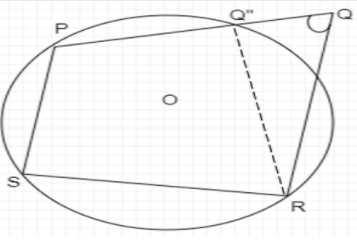Question
Question: If the sum of the opposite angles of a quadrilateral is \[{180^0}\], the quadrilateral is cyclic....
If the sum of the opposite angles of a quadrilateral is 1800, the quadrilateral is cyclic.
Solution
Cyclic Quadrilateral is a quadrilateral if all four vertices lie on the circle circumference. We prove this statement by assuming a point out of the circle which is collinear to two vertices of the quadrilateral and using the exterior angle property we prove that the point outside the circle coincides with the vertex of the quadrilateral.
Complete step-by-step answer:

We assume the quadrilateral PQRS has sum of opposite angles 180∘
∠PSR+∠PQR=180∘
∠SRQ+∠SPQ=180∘
We know there are three non-collinear points P, S, and R. We know a circle with centre O passes through three collinear points, so we assume point Q does not lie on Circle, so three collinear points are P, Q” and Q.
PQ”RS is a cyclic quadrilateral as all the vertices of the quadrilateral lie on the circle. We know that for a cyclic quadrilateral sum of opposite angles is 180∘. That is
∠PSR+∠PQ′′R=180∘ … (1)
But it is given
∠PSR+∠PQR=180∘ … (2)
So by comparing (1) and (2) we can write
∠PSR+∠PQR=∠PSR+∠PQ′′R
∠PSR−∠PSR+∠PQR=∠PQ′′R
∠PQR=∠PQ′′R … (3)
In triangle RQQ”, from exterior angle property which states that the exterior of the triangle is equal to the sum of opposite angles of the triangle.
∠PQ′′R=∠Q′′QR+∠Q′′RQ … (4)
Using Equation (3) in Equation (4)
∠PQR=∠Q′′QR+∠Q′′RQ
We can see from the diagram that
∠PQR=∠PQR+∠Q′′RQ ∠PQR−∠PQR=∠Q′′RQ 0=∠Q′′RQThis can be only true if, Q and Q” coincides. Therefore Point Q should lie on the circle.
Hence it is proved that if the sum of the opposite angles of a quadrilateral is 180∘ , the quadrilateral is cyclic.
Note: Students can get confused with the diagram, and they might assume the angle Q” as right angle but keep in mind unless you are given from the diagram or separately, don’t assume any angle on your own.
